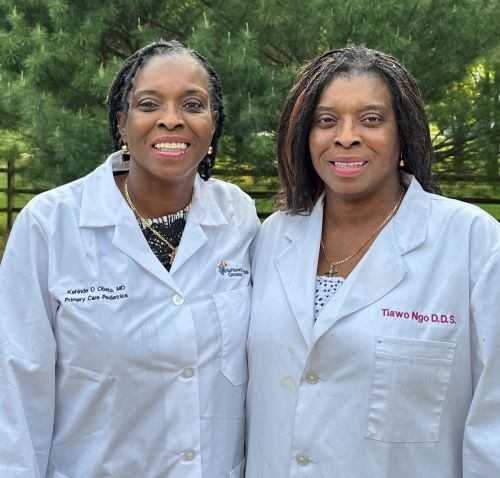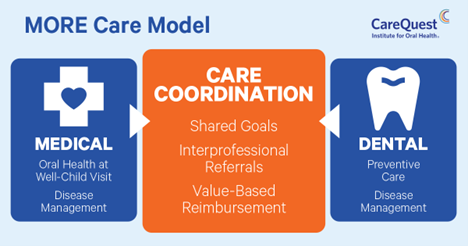Enter your email to receive the CareQuest newsletter:
May 16, 2023
Taiwo Ngo, DDS, has witnessed how medical-dental integration can help more people get the health care they need.
“I had a patient — a child — that Dr. Obeto referred to me,” Ngo says. “And they didn’t call, and so I called [the child’s guardian] to make the appointment.”
Ngo gets dental referrals frequently at Midwest Dental Center in Toledo, Ohio, for children who don’t have a dental home or who need access to care as part of her work with CareQuest Institute’s MORE CareTM pilot program. Quite a few of Ngo’s referrals come from Kehinde Obeto, MD, a pediatrician at Nationwide Children’s Hospital, also in Toledo, Ohio.

“[The guardian] asked, ‘Who is this?’” Ngo continues. “I replied, ‘I am Dr. Ngo, a dentist. I’m trying to make an appointment. Your child was referred to me.’"
Ngo says the guardian was excited by the recommendation from Obeto and willing to schedule an appointment for their child.
Ngo and Obeto have a very close relationship that goes beyond patient referrals: They are twin sisters from Nigeria who help underserved populations in the northwestern part of Ohio.
Even though Ngo and Obeto have referred patients to each other in the past, it is more formalized now that they are both participating in MORE Care™, which stands for Medical Oral Expanded Care. The initiative aims to integrate oral health competencies and capabilities into primary care practices and build patient-centered referral networks with local dental providers to improve oral health and overall health within communities.
Obeto says, “Sometimes if I see a kid who has caries, or I see a kid whose mom says, ‘Oh, he has a cavity, and we are trying to get him into the dentist, but they don’t have any openings for six months.’ And since I see the kid is in pain, sometimes I’ll call Dr. Ngo and say, ‘Look, I have this patient. Is this someone you can see right away?’”
The Goals of the MORE Care Pilot
The MORE Care Ohio pilot kicked off in November 2022 as a collaboration between CareQuest Institute and Oral Health Ohio, a coalition of statewide partners who educate and advocate to improve the state’s oral and overall health. MORE Care Ohio provides four participating care teams — each made up of one dental practice and one medical practice — with support in integrating oral health into primary care and coordinating referrals.
“MORE Care looks at the whole picture and doesn’t just break it up into slices,” Ngo says. “So now both the dental and the primary care providers approach the diagnosis and treatment of the patients together — a more integrated approach.”
A major reason CareQuest Institute was drawn to incorporating MORE Care in Ohio was because early childhood caries is the most common, preventable infectious disease among children in the US, and in Ohio, one out of every four children have not had an annual dental visit.

Historically, MORE Care programs in other states have shown significant improvements in preventive oral health outcomes for pediatric patients. These include increases in pediatric patients receiving oral health risk assessments, reviewing self-management goals relating to oral health, and receiving fluoride varnish.
Participants are hoping for similar improvements in Ohio. The four participating teams serve more than 32,000 patients — most of them either uninsured or enrolled in Medicaid.
That’s the case for many of Ngo’s and Obeto’s patients, too. And even for their patients enrolled in Medicaid, it can be a struggle to find a dentist who will accept it. If a patient does eventually find a dentist, it can take weeks or even months to book an appointment.
“Here in Toledo now, the number of dentists who take the Medicaid population is about 1% or 2%,” Ngo says. “A lot of them don’t. So those who do are kind of overburdened and overwhelmed with the system.”
According to research from the American Academy of Pediatrics, parents take their children to the pediatrician more often than the dentist at an early age, so it makes sense for pediatricians to integrate dental health into their practices.
Obeto says most parents don’t even know they should take their child to the dentist around their child’s first birthday or start using fluoride toothpaste when their child’s first tooth appears.
“Now part of the medical-dental integration, a part of our well-child visit has an integrated template for oral health,” Obeto says. “So we actually look at the child’s teeth and see if there’s any caries formation, and we also check to see if they’ve ever seen a dentist or if they’ve ever had fluoride varnish applied.”
Oral Health Ohio also connected participating medical teams with a fluoride varnish vendor that provides hands-on training. So now, pediatricians like Obeto are encouraged to apply fluoride varnish to patients’ teeth. With MORE Care and the help of her twin, Obeto can also easily get her patients into a dental home right away.
Ngo says, “This way we are introducing the children into the practice and the preventive visits are earlier, and so that means they are not as scared and they are used to it. Because now they’re coming in at an earlier age and getting things checked out and not having a problem.”
Integration Benefits Patients and Providers
One major benefit of medical-dental integration is it can help reduce costs to patients in the long run.
“By being healthy, you just need to see your doctor for the well visits and preventive visits,” Ngo says. “Money is not being spent on medications for different things or surgeries or different situations that could have been avoided.”
Ngo and Obeto say medical-dental integration is a big plus for providers, too — helping them stay connected without obstacles to communication or referrals.
“It allows different providers to come up with a comprehensive care plan for the same patient,” Ngo says. “So that way, it’s not just you looking at the patient and trying to find somebody for the patient to go to.”
It often works in both directions.
“It’s not just the dentists looking at the mouth and saying, ‘You need this,’” Obeto says. “If the dentist sees that there is a problem somewhere else, then they’ll refer the patient over to the medical side. And if the medical side sees there’s a dental problem, then they refer them to the dental side. So they take care of the patient as a whole.”
That connection between primary care providers and dentists — and in this case between twin sisters — can benefit that patient’s overall health.
“I recommend that [other providers] get involved [with MORE Care] because it’s a wonderful program,” Obeto says. “The mouth and the rest of the body are all related, so it’s a good way to make sure that everything is taken care of in one place.”
Just like it was for the guardian on the other end of the call with Ngo. When the guardian heard that they could get their child in for an appointment the very next week, they wanted to make the most of the opportunity and asked if they could bring in more of their children.
Ngo told them to all come in at the same time the following week.
“I saw them and saw [the guardian],” Ngo says.
The guardian was so impressed by the dental services that they recommended other family members to call and make an appointment with Ngo.
And they did.
“So, from that one appointment Dr. Obeto referred,” Ngo says, “I think I’ve cared for about 50 patients.”